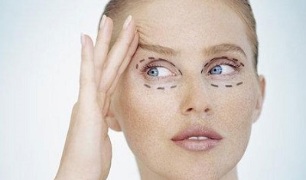
Eyelid plastic surgery in modern cosmetology is an indispensable operation. With it, you can change the shape of the eyelid, cut the eye, tighten the eyelid and eliminate many cosmetic defects in this area of the face.
This procedure involves eliminating excess fat deposits and eyelid skin. Transconjunctival sac angioplasty is particularly popular. It can make fatty hernia disappear with minimal loss, that is, it does not affect the skin.
Reading
Like any cosmetic surgery, blepharoplasty has many indications:
- Dangling eyelid skin (up and down);
- The "fat bags" in the bags under the eyes;
- "Eyelids" are aging; Ptosis (ptosis) at the lower corner of the eye, its shape changes: the incision is significantly reduced;
- Heavy eyelids (tiredness).
Age-related changes are early enough to put a time stamp on the eyelids because the skin around the eyes is very sensitive and soft. Thirty years later, many people believe that blepharoplasty is the only cure for sagging and fatty deposits in the area. Because of ignorance and fear, some people dare not take this step. And this is completely futile: the process is safe, effective, and if executed correctly, the negative effects are minimized. You just need to understand her better. Indeed, there are several types of blepharoplasty, each with its own characteristics.
View
In modern cosmetology, the types of blepharoplasty are different.
1. Correction of the upper eyelid
For many people, blepharoplasty of the upper eyelid is a real salvation, and the main goal is to get rid of drape. Surgery is performed through a skin incision along the wrinkles of the upper eyelid. It can remove excess skin. According to the patient's request, they can immediately undergo muscle plastic surgery to remove excess fat.
2. Correct the lower eyelid
The most popular type is blepharoplasty of the lower eyelid, which can eliminate edema, hernias and eye bags. The edges of the eyelashes are almost invisible. Doctors call this operation percutaneous or ciliary blepharoplasty. If the doctor chooses transconjunctival surgery, an incision is made on the inside of the eyelid. If you need to redistribute or remove the fatty tissue around the eyes, it may be necessary, and there is no need to remove the skin flap. This blepharoplasty is most commonly used by young patients.
3. Circular blepharoplasty
Circular eyelid surgery requires simultaneous correction of the upper and lower eyelids.
4. Laser blepharoplasty

Nowadays, many cosmetic clinics offer an excellent alternative to surgical eyelid lift (laser eyelid plastic surgery on various equipment). It does not require cuts or seams. The doctor controls the depth of laser penetration and the degree of heating of the epidermis. As a result, tissue damage and rehabilitation are minimized. This technology can safely and effectively stimulate the production of new collagen and elastin, so as to achieve the lifting effect. The process takes about 30 minutes, is easy to tolerate, does not require anesthesia, and does not cause hematoma formation. Only non-surgical eyelid plastic surgery can boast of minimal side effects.
In addition, professional beauticians can correct the shape of Asian eyes to form Caucasian folds. You can undergo plastic surgery to eliminate exophthalmos (the effect of bulging eyes), corneal eye disease (lift the lower eyelid to eliminate the sad expression in the eyes). All women who need eyelid plastic surgery should pay attention to such a drastic measure to restore the safety of the eyelids: almost all cosmetic procedures may cause complications.
Complications
The side effects after surgery mainly depend on the choice of eyelid surgery: complications can be early (occurring immediately after surgery) and late.
Early complications
- Edema stays on the face for more than a week after blepharoplasty: they may be accompanied by blurred vision and headaches.
- Bleeding caused by a small subcutaneous hematoma (blood from a damaged blood vessel accumulates under the epidermis) can be eliminated by puncturing or suturing the blood vessel. In this case, scars, seals, and subcutaneous nodules may be left.
- When the large blood vessels are damaged and blood accumulates in the back of the eyeball, the bleeding may be the result of hematoma. This complication is accompanied by pain, bulging eyeballs, and restricted eyelid movement. Threatening glaucoma or temporary vision loss.
- The lower eyelids turn inward and outward, and the eyes "open" excessively and become dry. In this case, a special exercise, namely massage, is required to train the circular muscles of the eyes. Sometimes supportive sutures are applied and surgery may be performed.
- Need a course of antibiotic infection.
Late complications
- Divergent seams will cause re-sewing.
- The formation of a cyst, and sometimes the cyst will disappear on its own, otherwise it will be removed by a specialist.
- Torn due to narrow tear duct.
- The discomfort of hot eyes.
- Dry keratoconjunctivitis (inflammation of the conjunctiva and cornea at the same time).
- Eyelid split (ptosis of the upper eyelid).
All the listed complications of blepharoplasty require additional treatment and repeated intervention by the doctor. However, therefore, you should not give up useful and important surgery to rejuvenate young people. Blepharoplasty can effectively solve the most painful problems in a short time: it removes the fatty tissue and excess skin around the eyes, reduces the manifestations of age-related changes, and performs plastic surgery on the muscles of this part of the face to change the eyeShape and shape to eliminate acquired and congenital eyelid defects. With such indicators, it is a sin not to take advantage of the unique opportunity to rejuvenate your eyes and shine.





















